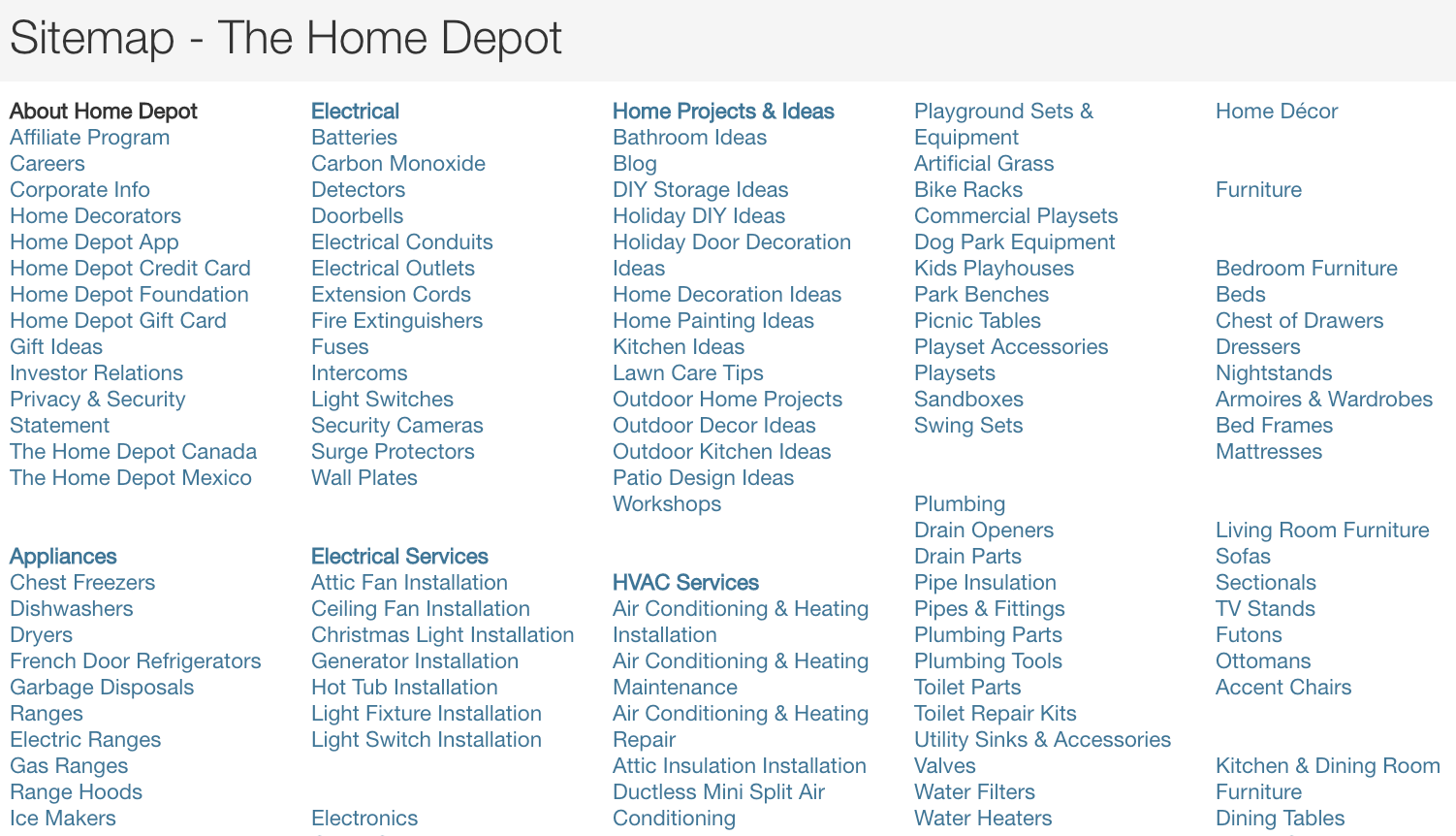What Is A Sitemap? Do I Need One?

Site Map. While this term you may be familiar with, what does it mean?
Do you need one? Where do you find one? How do you make one?
These are valid questions. For some, there may be more than one answer.
Today, we are going to take a deep dive into the world of sitemaps, so you can get the answers you need and be confident about the topic!
What is a sitemap?
Let’s start here.
Defining a sitemap is essential for several reasons, and we’ll go over the two main types that apply to technical SEO: XML and HTML sitemaps.
XML sitemap
An XML sitemap is a file that provides the canonical pages of a website, videos, and other important files that Google can discover when crawling the site.
Not only are these items listed in the file, but a sitemap can also provide details for Google to know – for example, when the page was last updated, and whether content is available in other languages.
As I mentioned, you can also provide details about content types such as videos, images, and news-related content, specifically in your XML sitemap.
According to the Google Developers sitemaps sectionFor certain types of content, the following may be included in your sitemap:
- A sitemap video entry can specify the time, rating, and age rating of the video.
- A sitemap image entry can include the location of the images included on the page.
- A sitemap news entry can include the title of the article and the date it was published.
Next, we’ll talk about what an HTML sitemap is and the differences between the two.
HTML sitemap
An HTML sitemap is more targeted to users on your site than Google.
This is a page on your site that has links to pages on your website – and in some cases, includes a little context about what those pages are.
Google mentions that you should try to create a consistent, clear hierarchy on your HTML sitemap because, while it’s not what it’s intended to be, it can help with indexing.
You can think of an HTML sitemap as a guide that users can use to navigate your site and find what they need.
An HTML sitemap should not be an attempt to replace important pages in navigating your site.
Comparing XML Sitemaps to HTML Sitemaps
So, what are the main differences between these two types of sitemaps? Let’s review.
XML
- The intent is Google and other bots.
- There is no hierarchy.
- Primarily used for indexing.
- You can submit via Google Webmaster Tools.
programming language
- intended for users.
- Hierarchy must be used.
- There is no place to submit it in Google Webmaster Tools.
Do you need a sitemap?
If you’re wondering if you need a sitemap, it depends!
First, let’s discuss the XML sitemap. There are a few questions you can ask to determine if you need an XML sitemap:
- What is the size of your site? Is it big enough that Google might lose the newly updated content when crawling?
- Is your site relatively new? If so, it may not have a large number of external links on the Internet pointing to it to help Google discover it. Even if your site is not new, and you have no external links, your answer to this question should be yes.
- Is your site content heavy? Do you have many photos, videos, news content, etc.?
- Does your site need a better structure that causes pages to not link together well? This can also be the case with archived and orphaned pages that you want to index.
If you answered yes to any of the above questions, then yes, you better have an XML sitemap.
Even if you answered “no” to all of the above, I recommend an XML sitemap for several reasons; If your site is growing, expanding, and other situations may arise, having a sitemap would come in handy!
Next, let’s review whether it makes sense to have an HTML sitemap. Depending on where you look, the answer is either yes or no.
It’s common knowledge that HTML sitemaps are an outdated concept, but that doesn’t mean you shouldn’t have one.
An XML sitemap contains the information needed for Google to crawl, index, and learn about other important information about these pages. However, an XML sitemap does not show a hierarchy like an HTML sitemap.
Google will crawl links on your site, and including an HTML sitemap may allow Google to better understand your site’s structure and relationships.
This is most useful for sites with an incredibly large number of pages.
So, is having an HTML sitemap critical? No it is not.
Nor is it a cure-all for poorly engineered and interfering websites. Although not a critical component to success, it has shown benefits that make it a best practice.
To close this thread, I’d recommend having an XML and HTML sitemap because let’s be honest, why not, when the positives clearly outweigh the negatives?
Now you might be wondering how to create these two assets and what to do with them – so, let’s move on to some of the ways you can create these files and where to place them on the site.
How to create an XML sitemap
First, we’ll go over how to create sitemaps from scratch, and then get into some great tools that can do it for you.
XML sitemaps contain specific criteria in order to be valid.
Here are some specific requirements for XML sitemaps:
- Start with a tag
And finish with the tag closed . - Include the protocol you are using in a tag
. - Each URL entry must contain a tag
as the main XML tag. - Include a sub entry
for each parent tag . - Each sitemap can only contain up to 50,000 URLs and 50MB.
- It must be UTF-encoded.
XML sitemap best practices
Now, let’s take a look at some of the key best practices when it comes to creating XML sitemaps:
- Only URLs that you want to be indexed should appear in your Sitemap. This means no redirected URLs, non-canonical URLs, or pages marked as without an index.
- Do not use session identifiers.
- Include primary only if you have two versions (mobile and desktop) of your site.
- Include media assets such as videos, photos, and news.
- Use hreflang to show Google that there are alternative language versions of your website.
- google documents Indicates that it is taking advantage of
, but only if it is consistent and verifiable. If you can’t keep this accurate, don’t use it. - Google ignores my tag
And For now, according to John Mueller for that matter Search podcasts outside of the registry. - Google will not crawl your URLs in the order listed, nor does it guarantee indexing.
- The sitemap must be updated regularly – automatically or manually – otherwise Google may not trust it.
Now, if you feel lost reading those preliminary requirements, that’s okay, because there are tools out there to help you achieve your desired results! We will review some of them later in this article.
Check out the duplicate below:
 Screenshot from lowes.com, January 2023
Screenshot from lowes.com, January 2023How to create an HTML sitemap
When compiling an HTML sitemap, remember that its purpose is to serve a user on the site and help Google understand your website hierarchy.
You don’t want this page not to be indexed by Google; Keep it crawlable!
You’ll want to make sure that you’re not just dumping thousands of links on an HTML sitemap page with no sense of organization, because this isn’t going to help anyone – including bots.
 Screenshot from Home Depot, January 2023
Screenshot from Home Depot, January 2023Best practices for an HTML sitemap
Let’s go over some quick best practices when it comes to HTML sitemaps:
- Arrange the page structure to align with the structure of your website. You’ll want to make sure the hierarchy is easy to understand.
- The HTML sitemap should be located where the user can find it easily. You will often see it in the footer links of the site.
- Use anchor text that represents a value to the user.
Need a little help getting started? Don’t worry – there are plenty of tools to help you.
Sitemap generator tools
There are a number of tools to help you create different types of sitemaps. Let’s go over a few now.
XML sitemap generator tools
- Frog scream This tool is a great option for creating a sitemap, especially if you want to generate one after crawling your URLs. Screaming Frog is free if you have fewer than 1,000 URLs, but you’ll have to buy a license if you have more.
- XML-Sitemaps.com This web based application allows you to enter your website URL and it generates an XML file for you. This is a free tool for up to 500 URLs.
Depending on the CMS you’re leveraging, there are also thousands of XML sitemap generator plugins out there, but be careful the best generator tools have their limitations, so be sure to double check the output.
Here are some popular XML sitemap plugins for WordPress:
HTML sitemap generator tools
- comThis is a free online tool where you can scan your website URL or upload a document to generate an HTML sitemap. As we discussed earlier, there may be better methods than a generator if your site is poorly architectured.
- creeper: As Eli mentions, if you have a large site and you’re already using a crawler like OnCrawlAnd Deep Crawlscreaming frog, or SiteBulbYou can make use of the crawl output to help build your HTML sitemap.
Like XML sitemaps, there are also a variety of CMS plugins for creating HTML sitemaps. Here are some of them for WordPress:
- Simple sitemap.
- All in one SEO (Can help with both XML and HTML sitemaps).
- A companion sitemap generator (XML and HTML sitemaps can also be generated).
In conclusion
Sitemaps have been around in the world of SEO for quite some time as a way to help search engines discover and crawl websites.
And while having a sitemap isn’t always necessary for every site, it sure doesn’t hurt – and can be especially useful for both new and large sites.
When you’ve determined your next steps for creating a sitemap for your website – be it XML or HTML – I hope you can take advantage of this guide to determine the path most appropriate to your site’s needs.
More resources:
- 10 Best Sitemap Generators for Faster and More Productive Crawls
- 5 sitemap examples demonstrating best practices in practice
- Advanced Technical SEO: A Complete Guide
Featured image: Sammby/Shutterstock




